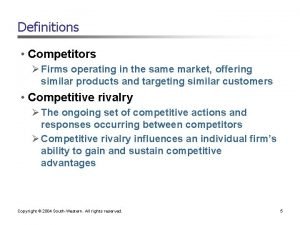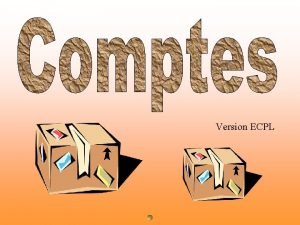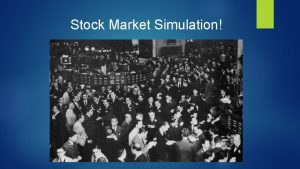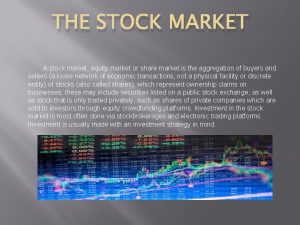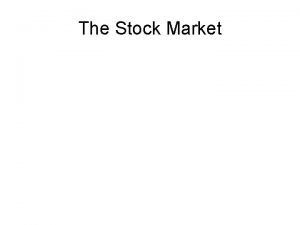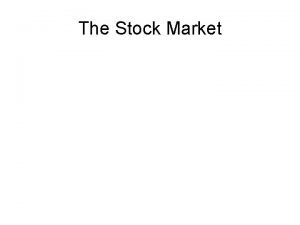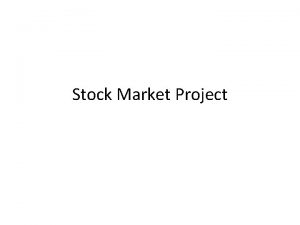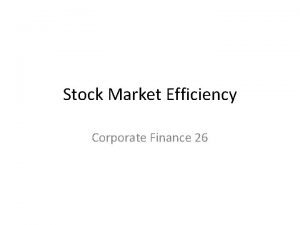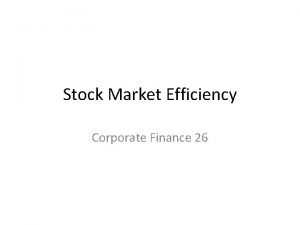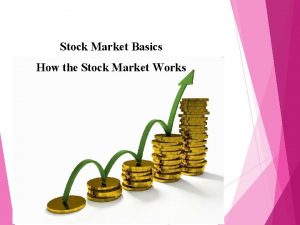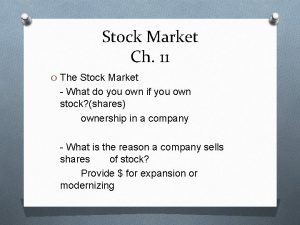Does the Stock Market Value the Firms Potential











![Variables variables indication Market value Excess value= [market value-booked value]/sales Emissions /sales On-site releases/sale Variables variables indication Market value Excess value= [market value-booked value]/sales Emissions /sales On-site releases/sale](https://slidetodoc.com/presentation_image_h/a3f53be4addf7663d268abf28262c3e9/image-12.jpg)






- Slides: 18

Does the Stock Market Value the Firm’s Potential Chemical Risk Released and Transferred? : Empirical Study on the Japanese Pollutant Release and Transfer Register System Yukiko Omata Tokyo Institute of Technology Department of Social Engineering 1

Back ground of my research Conventional policy (command-control regulations, environmental taxies) → voluntary instruments, information provision policies It is important for firms to be valued for less pollution in the market. Why market values the firms with less polluting? →Firms with high polluting levels may face greater risk of environmental liabilities and lawsuit. → Investors are therefore likely to prefer firms that pollute lower levels. 2

Purpose of my research 1. Does financial market value pollutions of the firm negatively? 2. Does financial market distinguish the type of pollutions? 3

The Pollutant Release and Transfer Register (PRTR) system 1. This is information provision policies in Japan. 2. This system has been in force since 2001. 3. The facilities handling chemical substances potentially hazardous to the environment need to estimate annual amounts. 4. The government has been releasing to the public annually. 4

On-site releases and Off-site transfers Releases to air manufacture Raw materials Transfers to off-site Releases to the land Releases to the public Transfers to sewage water bodies 5

The amounts of reported releases and transfers. 600000 500000 400000 300000 200000 100000 0 2001 2002 on-site releases 2003 2004 off-site transfers 2005 total 2006 6

The ratio of emissions to total amounts 100% 90% 80% 70% 60% 50% 40% 30% 20% 10% 0% 2001 2002 off-site transfers 2003 2004 2005 2006 on-site releases 7

Previous studies Economic performance Hart and Ahuja(1996) ROA ROE ROS Khanna, Quimio and. Bojilova (1998) King, A. A. and Lenox, M. J. (2002) Dowell, Hart and Yeung(2000) Konar and Cohen(2001) Abnormal returns Total - - - × Tobin’s q ROA Tobin’s q - - - Tobin’s q - Findings on-site off-site releases transfers - + 8

Contribution of this paper 1. There is few studies that relationships between market value and emission reduction in Japan. 2. I distinguishes between on-site releases and off-site transfers to examine whether information provision has differential impacts on pollutants. 9

Data Sample 140 firms from Nikkei 300 (food and beverage; pulp and paper; chemical; pharmacy; oil; tuber; steel; nonmetal; machinery; metalworking; electric equipment; automobile; electric machinery; precision instrument; textiles; transportation; construction; gas) 840 firm-year observations for the year 2001 -2006. 10

Model 11
![Variables variables indication Market value Excess value market valuebooked valuesales Emissions sales Onsite releasessale Variables variables indication Market value Excess value= [market value-booked value]/sales Emissions /sales On-site releases/sale](https://slidetodoc.com/presentation_image_h/a3f53be4addf7663d268abf28262c3e9/image-12.jpg)
Variables variables indication Market value Excess value= [market value-booked value]/sales Emissions /sales On-site releases/sale Off-site transfers/sales Total/sales current earnings/sales profitability 12

advertisement expenditures/sales R&D/sales Consumer pressure Degree of innovativeness Emissions/sales* current earnings/sales Firms with high profitability have less pollutions Emissions/sales* advertisement/sales Firms with high consumer pressure have less pollutions 13

Regression Analysis Technique 1. Endogeneity problem Unknown variable may affect both reductions of emissions and the market value of the firm. 2. Causation between market value and chemical risk. (not correlation) →Lagged variables help ascertain the causal relationships between market valuation and environmental performance 14

Result variables total Emissions/sales -0. 021 Emissions/sales* -0. 34 current earnings/sales Emissions/sales* advertisement/sales On-site releases -0. 95** Off-site transfers +0. 0094 -9. 08** -0. 23 -10. 33** +183. 9** -1. 71** ***, ** and * indicate statistical significance at the 1% level, the 5% level and the 10% level respectively 15

Total effects On-site releases - Off-site releases + total + 16

Findings 1. Firms with high on-site releases have negatively effect to market value. 2. Firms with high off-site transfers and total pollutions have positively effect to market value. 3. Firms facing high consumer pressure have less total emissions or off-site transfers. 4. Firms facing high consumer pressure have more on-site releases. 17

Conclusions Market values firms with less polluting in Japan. 18
 Sales potential vs market potential
Sales potential vs market potential Perfectly competitive short run supply curve
Perfectly competitive short run supply curve Firms operating in the same market
Firms operating in the same market In a competitive price-searcher market, the firms will
In a competitive price-searcher market, the firms will Market structure dominated by a few large profitable firms
Market structure dominated by a few large profitable firms Penciptaan nilai adalah
Penciptaan nilai adalah Market follower
Market follower Market segmentation objectives
Market segmentation objectives Long-term debt preferred stock and common stock
Long-term debt preferred stock and common stock Apa itu stock dalam kitchen
Apa itu stock dalam kitchen Common stock characteristics
Common stock characteristics Pramv
Pramv Flaccid cell
Flaccid cell Water potential in plants
Water potential in plants Osmotic potential vs water potential
Osmotic potential vs water potential Graded potential vs action potential
Graded potential vs action potential Graded potentials
Graded potentials Action potential
Action potential Graded potential vs action potential
Graded potential vs action potential


